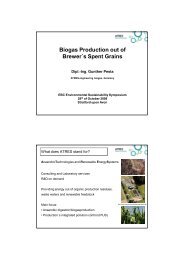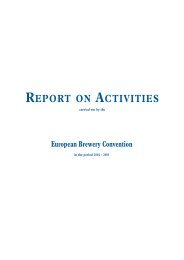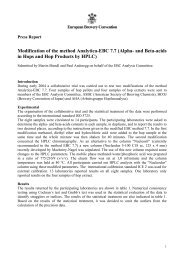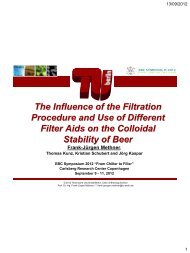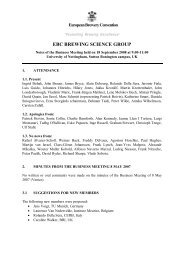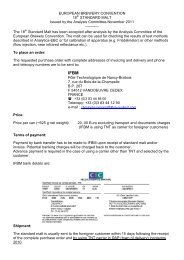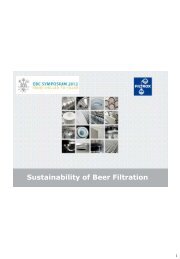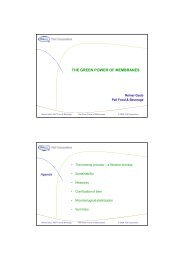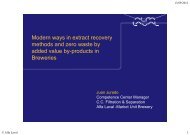Product Carbon Footprinting: Beer - European Brewery Convention
Product Carbon Footprinting: Beer - European Brewery Convention
Product Carbon Footprinting: Beer - European Brewery Convention
You also want an ePaper? Increase the reach of your titles
YUMPU automatically turns print PDFs into web optimized ePapers that Google loves.
<strong>Product</strong> <strong>Carbon</strong><br />
<strong>Footprinting</strong>: <strong>Beer</strong><br />
Anke Fendler<br />
Dept. Food Manufacturing<br />
Technologies, Campden BRI<br />
EBS, 2628 October 2008<br />
Campden BRI<br />
Subjects Covered<br />
• What is a carbon footprint?<br />
• <strong>Product</strong> carbon footprinting and PAS 2050<br />
• Example: the carbon footprint of a bottle of ale<br />
• What next?<br />
EBS, 2628 October 2008<br />
Campden BRI
What is a <strong>Carbon</strong> Footprint?<br />
‘The total set of greenhouse gases (expressed in CO 2 e)<br />
entering the atmosphere as the result of a given activity<br />
or product’<br />
May be associated with:<br />
‣ Activities in a country<br />
‣ All the activities of a company<br />
‣ The operation of a site of a business<br />
‣ The manufacture and use of a product<br />
EBS, 2628 October 2008<br />
Campden BRI<br />
GHG Emissions from Human Activities<br />
Figure from Office of Climate Change www.occ.gov.uk<br />
Campden BRI
Business CF vs <strong>Product</strong> CF<br />
In the past, companies wanting to measure their carbon footprints<br />
have focused on their own emissions, but now they are increasingly<br />
concerned with emissions across their entire supply chain<br />
Company level<br />
For example: a brewery<br />
Account for all activities of the<br />
company<br />
ISO 140641:2006<br />
GHG Protocol<br />
EBS, 2628 October 2008<br />
<strong>Product</strong> level<br />
For example: one brand of<br />
bottled ale<br />
Account for the whole life cycle<br />
of the product<br />
PAS 2050<br />
Campden BRI<br />
Why PCF?<br />
Measuring the carbon footprint of products across a full<br />
product life cycle is a powerful way for companies to collect<br />
the information needed to:<br />
‣ Reduce GHG emissions<br />
‣ Identify cost saving opportunities<br />
‣ Assist decision making on suppliers, materials, product<br />
design, manufacturing processes, etc.<br />
‣ Demonstrate environmental / corporate responsibility<br />
‣ Meet customer demands for information on product carbon<br />
footprints<br />
‣ Meet demands from “green” consumers<br />
EBS, 2628 October 2008<br />
Campden BRI
PAS 2050<br />
PAS 2050:2008. ‘Specification for the assessment of the life<br />
cycle greenhouse gas emissions of goods and services’<br />
• PAS 2050 explains how to assess GHG emissions of an individual<br />
product, either a physical good or a service, across its entire life cycle:<br />
– from raw materials through all stages of production (or service<br />
provision), distribution, use and disposal<br />
• Developed in partnership by BSI, The <strong>Carbon</strong> Trust and Defra in the<br />
UK, with significant input from other stakeholders<br />
• The method was tested across a diverse set of sectors and product<br />
types<br />
• PAS 2050 final version expected Oct 2008<br />
EBS, 2628 October 2008<br />
Campden BRI<br />
• Setting CF objectives:<br />
How to start<br />
‣ Internal hotspot analysis?<br />
‣ Certification and communication to consumer?<br />
• Internal engagement:<br />
‣ Senior management support<br />
‣ Representatives from all areas of the business should be<br />
involved<br />
• Selection of product:<br />
‣ What brands are most important from a differentiation or<br />
competitive perspective?<br />
‣ What products are likely to yield the largest emissions<br />
reduction opportunities?<br />
Campden BRI<br />
EBS, 2628 October 2008
• Supply chain engagement:<br />
How to start<br />
Suppliers are critical to understanding the<br />
product’s life cycle and for gathering data<br />
As part of the initial internal scoping phase, it’s useful to think<br />
through:<br />
‣ Who are the key suppliers, retailers, waste management<br />
companies, etc.?<br />
‣ What information can they provide?<br />
‣ How willing and / or able are they to support the project?<br />
‣ Who will take responsibility for the relationship?<br />
EBS, 2628 October 2008<br />
Campden BRI<br />
Example:<br />
The carbon<br />
footprint of a<br />
bottle of ale<br />
EBS, 2628 October 2008<br />
Campden BRI
Proposed PAS 2050 Methodology<br />
The assessment should include GHG emissions arising from<br />
all supply chain steps:<br />
Raw<br />
Materials<br />
Manufacture<br />
Distribution/<br />
Retail<br />
Consumer<br />
Use<br />
Disposal<br />
Both direct and indirect emissions are included:<br />
Direct emissions from:<br />
‣ Process reactions, gas<br />
leakages<br />
‣ Burning of fuel<br />
EBS, 2628 October 2008<br />
Indirect emissions from:<br />
‣ Energy consumption<br />
‣ Extraction of fuels<br />
‣ Extraction and manufacturing of<br />
raw materials and packaging<br />
‣ Transport and distribution of<br />
materials<br />
‣ Waste disposal<br />
Campden BRI<br />
Steps to calculating a CF<br />
Process<br />
map<br />
Boundaries &<br />
prioritisation<br />
Build process map of product’s life cycle, from<br />
raw materials to disposal<br />
Confirm boundaries and perform highlevel<br />
footprint calculation to help prioritise efforts<br />
Data<br />
Collect data on material amounts, activities and<br />
emissions factors across all life cycle stages<br />
Calculation<br />
Calculate the product carbon footprint<br />
Uncertainty<br />
Assess precision of the footprint analysis<br />
Adapted from: Guidance to PAS 2050, Draft version, <strong>Carbon</strong> Trust – Defra BSI<br />
EBS, 2628 October 2008<br />
Campden BRI
The process map<br />
Consumer Use<br />
Disposal<br />
Raw Materials<br />
Distribution/<br />
Retail<br />
Manufacture<br />
EBS, 2628 October 2008<br />
Campden BRI<br />
Defining the boundaries<br />
• Once a highlevel process map has been developed, the<br />
boundaries for the CF calculations are determined<br />
• The key principle is to include all “material” emissions<br />
generated as a direct or indirect result of the PU being<br />
produced<br />
• Exclusions:<br />
‣ PAS 2050 allows “immaterial” emissions to<br />
be excluded – any single source
Types of data<br />
Two types of data are necessary to calculate a<br />
carbon footprint:<br />
• Activity data refers to all the quantities involved in<br />
the product’s life cycle (material inputs and<br />
outputs; energy used; transport; etc.)<br />
• Emission factors provide the link that converts<br />
these quantities into the resulting GHG emissions:<br />
‣ For electricity: e.g. in CO 2 e per kWh<br />
‣ For fuel: e.g. in CO 2 e per litre of fuel used<br />
‣ ...<br />
EBS, 2628 October 2008<br />
Campden BRI<br />
Data sources<br />
Data can come from either primary or secondary sources:<br />
• Primary activity data refers to data measured<br />
internally or by someone else in the supply chain<br />
‣ PAS 2050 states that primary activity data must be<br />
used for all processes and materials which your<br />
organisation owns, operates or controls<br />
• Secondary data comes from sources other than direct<br />
measurement (LCA databases, industry reports, etc.)<br />
‣ Where primary data is not available (e.g. for some<br />
raw materials), secondary data may be used<br />
EBS, 2628 October 2008<br />
Campden BRI
Calculation<br />
The basic equation for product carbon footprinting is the sum<br />
of all material inputs and outputs multiplied by their emission<br />
factors, across all activities in the product’s life cycle:<br />
Lifecycle step 1: AD 1 x EF 1 = CF 1<br />
Lifecycle step 2: AD 2 x EF 1 = CF 1<br />
...<br />
Overall product life cycle carbon footprint:<br />
CF<br />
AD: activity data, measured in mass, volume, energy, etc.<br />
EF: emission factor, measured in CO 2 e per unit of mass, volume, ...<br />
CF: carbon footprint, measured in CO 2 e per product unit<br />
Campden BRI<br />
EBS, 2628 October 2008<br />
Uncertainty<br />
• Sources of uncertainty:<br />
‣ Missing data for parts of the supply chain<br />
‣ Data of questionable quality: not specific, not reliable, ...<br />
If the goal is to certify and communicate the product footprint to<br />
customers, then it will require more precise calculations than<br />
simply using the footprint data internally to improve processes.<br />
• Reducing uncertainty:<br />
‣ Replace secondary/reference data with good quality<br />
primary activity data<br />
‣ Improve the model used to calculate the carbon footprint to<br />
make it more representative of reality<br />
Campden BRI<br />
EBS, 2628 October 2008
Summary & Hotspots<br />
EBS, 2628 October 2008<br />
Campden BRI<br />
Summary & Hotspots<br />
EBS, 2628 October 2008<br />
Campden BRI
Reducing carbon emissions...<br />
• Use the carbon footprint as a starting point to<br />
reduce GHG emissions<br />
‣ provides a baseline against which to measure future<br />
reductions<br />
‣ helps identify opportunities to reduce emissions across<br />
all phases of the product’s life cycle<br />
The analysis offers a way to engage with<br />
suppliers, distributors, retailers and<br />
consumers on how to reduce emissions<br />
EBS, 2628 October 2008<br />
Campden BRI<br />
Opportunities for Improvement<br />
• Glass Packaging:<br />
‣ virgin inputs 0.6 t CO 2 e per ton of glass produced<br />
recycled inputs 0.3 t CO 2 e per ton of glass produced<br />
‣ Light weight bottles: “narrow neck press & blow”<br />
• In store and home refrigeration:<br />
‣ More efficient refrigeration technologies<br />
‣ Pasteurise beer to make it ambient stable?<br />
EBS, 2628 October 2008<br />
Campden BRI
Opportunities for Improvement<br />
• Barley (Agriculture):<br />
‣ Switch to suppliers using more sustainable<br />
agricultural techniques:<br />
There is a potential for agricultural lands to reduce carbon emissions<br />
and even sequester atmospheric carbon as organic carbon in the soil<br />
by adopting notill techniques, integrating fertilizer and pest control<br />
practices, and increasing the efficiency of irrigation systems<br />
• Brewing operations:<br />
‣ Include energy/carbon criteria in<br />
purchasing/supplier choices<br />
‣ Technology choice (e.g. upgrading<br />
equipment to be more energy efficient)<br />
Campden BRI<br />
EBS, 2628 October 2008<br />
What Next?<br />
EBS, 2628 October 2008<br />
Campden BRI
References<br />
‣ PAS 2050:2008. http://www.bsiglobal.com/en/Standardsand<br />
Publications/IndustrySectors/Energy/PAS2050/<br />
‣ Garnett, T., 2007, The alcohol we drink and its contribution to<br />
the UK's greenhouse gas emissions: A discussion paper. Food<br />
Climate Research Network.<br />
‣ Talve, S., 2001, Life cycle assessment of a basic lager beer.<br />
International Journal of Life Cycle Assessment, V. 6, No. 5, p.<br />
293298.<br />
‣ , 2008, The <strong>Carbon</strong> Footprint of Fat Tire Amber Ale. The<br />
Climate Conservancy: http://news.newbelgium.com/wpcontent/thecarbonfootprintoffattireamberale2008<br />
redactedrfs.pdf<br />
Campden BRI<br />
EBS, 2628 October 2008<br />
Ongoing work at Campden BRI<br />
ü<br />
ü<br />
ü<br />
ü<br />
ü<br />
Several Defra and <strong>Carbon</strong> Trust funded projects are ongoing<br />
in order to test the draft method<br />
Campden BRI is involved in two projects (FO0404 and<br />
FO0406/9) looking at food processing and consumer use<br />
GHG emissions<br />
4 staff in the Food Manufacturing Technologies Department<br />
involved with carbon footprinting, joint carbon footprinting<br />
service set up with ADAS<br />
Help now available for food companies in carbon footprinting;<br />
training courses and consultancy<br />
The aim is to identify areas to reduce footprints and cost<br />
EBS, 2628 October 2008<br />
Campden BRI
Important dates<br />
29 Oct 2008 Official Defra PAS 2050 launch.<br />
6 Nov 2008 ADAS. <strong>Carbon</strong> Solutions. Peterborough.<br />
9 Dec 2008 Training course: Introduction to carbon footprinting<br />
24 Feb 2009 Focus on carbon footprinting in the food industry<br />
Further courses and seminars in our training brochure<br />
EBS, 2628 October 2008<br />
Campden BRI<br />
CONTACT DETAILS:<br />
Anke Fendler<br />
Tel.: 01386 842079<br />
a.fendler@campden.co.uk<br />
EBS, 2628 October 2008<br />
Campden BRI



